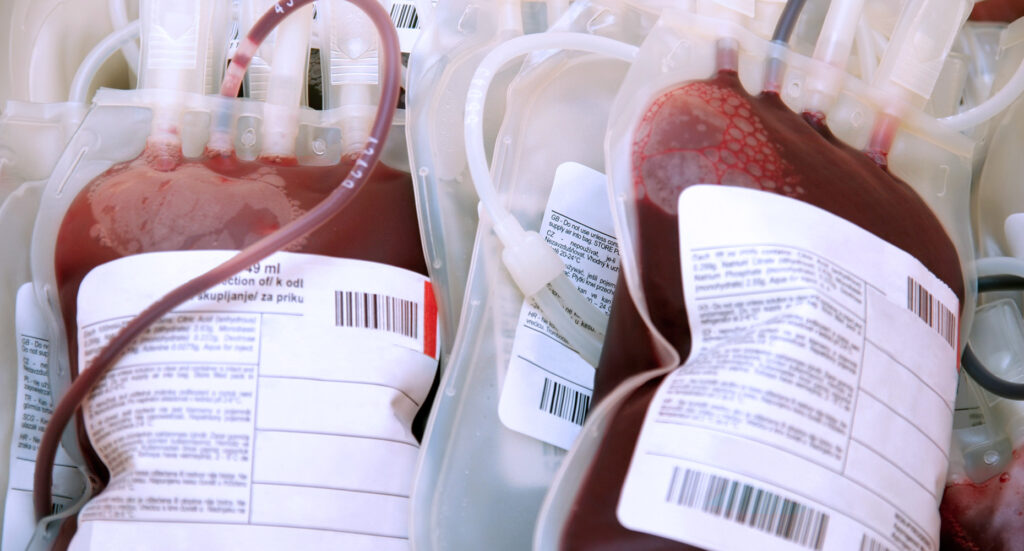Celebrate World Blood Donor Day 2021
Everyone is familiar with blood - the viscous oxygen-rich fluid coursing through our veins and delivering nutrients to our bodies' cells - but what you may not know is that every two seconds, someone in the United States needs blood and/or blood platelets. And, while technological advances in medicine abound, there is still no means of manufacturing blood. It can only come from donors.


Celebrate World Blood Donor Day 2021
June 8, 2021
.
Everyone is familiar with blood - the viscous oxygen-rich fluid coursing through our veins and delivering nutrients to our bodies' cells - but what you may not know is that every two seconds, someone in the United States needs blood and/or blood platelets.1 And, while technological advances in medicine abound, there is still no means of manufacturing blood. It can only come from donors.
Every June 14, we celebrate World Blood Donor Day. It's a worldwide opportunity to raise global awareness of the need for safe blood and blood products for transfusion, and to recognize the contribution volunteer blood donors make to the improvement of health. A blood product is any therapeutic substance derived from human blood, including whole blood and other blood components for transfusion, and plasma-derived medicinal products.2
This year's campaign, "Give blood and keep the world beating," highlights the role young people can play in ensuring a safe blood supply. The specific objectives of this year's campaign are to:
• Thank blood donors in the world
• Create wider public awareness of the need for regular, unpaid blood donation
• Promote the role blood donation plays in enhancing community solidarity
• Encourage youth to embrace the call to donate blood
• Celebrate the potential of youth as partners in promoting health

Donations Make a Difference
According to the American Red Cross, approximately 36,000 units of red blood cells are needed every day in the U.S.1 Transfusions using safe blood are a crucial element of healthcare. Unsafe transfusion practices expose patients to the risk of serious adverse reactions and transfusion-transmissible infections.
Transfusion can occur for a number of reasons. In the U.S., nearly 21 million blood components are transfused each year.1 Blood components include plasma, red blood cells, white blood cells and platelets. Patients may receive transfusions to replace blood lost through surgery or injury. Transfusions are also used to support patients with cancer, anemia, sickle cell anemia, bleeding disorders or other critical illnesses.3
According to the American Red Cross, each year, approximately 6.8 million people in the U.S. donate blood; however, the organization notes that this represents only 3% of eligible donors.1 Because blood components have a limited shelf life, and some blood types are in short supply, more donors are needed to meet patient requirements.
Keeping Supplies Safe
Although the U.S. blood supply is safer than ever, protecting the health of donors and patients is paramount. According to the Centers for Disease Control (CDC), organizations collecting blood take a number of steps to help ensure collected blood is safe to use: 4
• Potential blood donors are asked a set of standard questions to help determine if they are in good health and free of any diseases transmissible by blood transfusion. Donors who are considered to be unwell, or are at risk for transmitting a disease by blood transfusion, are not allowed to donate blood.
• Donated blood is tested for blood type (ABO group) and Rh type (positive or negative) to ensure that patients receive blood that matches their blood type.
• Before transfusion, the donor and blood unit are tested for certain proteins (antibodies) that may cause adverse reactions in a person receiving a blood transfusion.
• All blood for transfusion is tested for evidence of certain infectious disease pathogens. These tests include, but are not limited to, hepatitis B and C viruses and human immunodeficiency virus (HIV). Some other testing may include testing for the COVID-19 antibodies.
• Collection centers use sterilized needles that are discarded after one use.
Additionally, a number of federal agencies play an ongoing role in monitoring practices to keep the nation's blood supply safe. This process includes:4
• Facility inspections
• Surveillance for errors, accidents and adverse events
• Ongoing evaluation of practices related to the collection and transfusion or transplantation of blood components

Make This Year Count
There are many ways that you and your patients can join in on World Blood Donor Day 2021. Of course, the most obvious activity is to donate blood, and finding a way to donate is easy:
• The American Red Cross website lists local blood drives. There is also an app that makes it easy to find places to donate, schedule appointments and stay updated on promotions. The app will even let you know when your blood is on its way to a patient.
• Many towns have non-profit blood banks that collect blood donations and provide a region's hospitals with a wide range of services.
• Check local news outlets for activities being held in conjunction with World Blood Donor Day 2021.
• Ask your employer, church, or other community location to host a blood drive.
In preparing to donate blood, it is wise to check out any special precautions related to COVID-19 and review eligibility requirements. In general, donors must be in good health and free of diseases that can be transmitted by blood transfusion. Also, there are age and weight requirements. These vary based on the location and/or type of blood donation. Finally, international travel and some medications may affect eligibility.
Typically, a donor will give roughly one pint of blood during a donation. This is about one-tenth of the blood in a person's body. Depending on the type of blood component that is donated, the body will replenish itself in a matter of hours to weeks.
Even those who can't give blood can get involved. Volunteers are often needed for blood drives, or ineligible donors can ask a family member or friend to donate in their place. Financial contributions are another way of supporting safe blood collection on a local, national or global level.
It's likely that many eligible donors do not give blood simply because they don't think about it. So, spreading the word is an easy, but very helpful, way to support the cause! Practices can certainly play a role by including information about donating blood in newsletters, on websites and social media outlets, or in the office.
Currently, the United States is experiencing a blood donor shortage, making this World Blood Donor Day more important than ever. Whether large or small, your practice can inspire future donors through education and encouragement. For more information on blood donation, blood transfusion and blood safety, go to:
American Red Cross
World Health Organization
Centers for Disease Control
National Heart Lung and Blood Institute
Footnotes:
1 "US Blood Supply Facts." How Blood Donations Help, American Red Cross. Accessed 31 May 2021, https://www.redcrossblood.org/donate-blood/how-to-donate/how-blood-donations-help/blood-needs-blood-supply.html.
2 "Blood Products." Health Topics, World Health Organizations. Accessed 31 May 2021, https://www.who.int/health-topics/blood-products#tab=tab_1.
3 "Blood Transfusion." Health Topics, NIH National Heart Lung and Blood Institute. Accessed 31 May 2021, https://www.nhlbi.nih.gov/health-topics/blood-transfusion.
4 "Monitoring Blood Safety." Blood Safety, Centers for Disease Control, 31 Jan 2019, https://www.cdc.gov/bloodsafety/monitoring/blood_safety.html.
Related Articles
Introducing the HemoCue Customer Portal